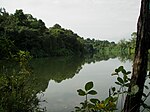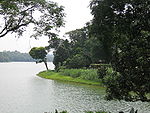The following is a list of reservoirs in Singapore.
There are a currently 17 reservoirs which are designated as national water catchment areas and are managed by the Public Utilities Board (PUB) of Singapore. [1] [2]
Reservoirs
| Name | Surface area (Total) |
Storage capacity (m3) | Period of construction | Construction order | Image | Remarks |
|---|---|---|---|---|---|---|
| Bedok Reservoir | 88 ha | 12,800,000 | 1981 [3]-1986 [4] | 14 [5] |

|
|
| Jurong Lake | 70 ha | 11 [5] |

|
In addition to a number of artificial islands such as the Chinese and Japanese Gardens, Jurong Lake is planned to be a future recreational hub for the western side of the island. | ||
| Kranji Reservoir | 450 ha [6] | 15,850,000 [6] | 1971-1975 [3] | 5 [5] |

|
|
| Lower Peirce Reservoir (formerly called "Kallang River Reservoir" and "Peirce Reservoir") | 6 ha | 2,800,000 [7] | 1900-1912 [3] | 2 [5] |

|
Source of the
Kallang River, Singapore's longest river. Connects to Upper Thomson Road by a waterside trail. |
| Lower Seletar Reservoir | 360 ha | 9,400,000 | 1941-1969 [3] | 13 [5] |

|
|
| MacRitchie Reservoir (formerly called "Thomson Road Reservoir") | 4,200,000 [7] | 1890-1894 [3] | 1 [5] |

|
||
| Marina Reservoir | 240 ha [8] | 2005-2008 [9] | 15 [5] |

|
||
| Murai Reservoir* | 1977-1981 [3] | 7 [5] | ||||
| Pandan Reservoir | 1971-1974 [10] | 6 [5] |

|
|||
| Poyan Reservoir* | 1977-1981 [3] | 8 [5] | ||||
| Pulau Tekong Reservoir* | 1977-1979 [10] | 12 [5] | ||||
| Punggol Reservoir | 16 [5] | Opening ceremony held on 3 July 2011. Together with Serangoon Reservoir will increase catchment area by 5,500ha. | ||||
| Sarimbun Reservoir* | 1977-1981 [3] | 9 [5] | ||||
| Serangoon Reservoir | 17 [5] |

|
Opening ceremony held on 3 July 2011. Together with Punggol Reservoir will increase catchment area by 5,500ha. | |||
| Tengeh Reservoir* | 1977-1981 [3] | 10 [5] | ||||
| Upper Peirce Reservoir | 304 ha | 27,800,000 [7] | 4 [5] |

|
||
| Upper Seletar Reservoir (formerly called "Seletar Reservoir") | 324 ha | 3 [5] |

|
*located in SAF restricted zones
Reservoirs that are currently in service
Reservoirs that are no longer in service
References
- ^ "Local Catchment Water". PUB, Singapore's national water agency. 2 August 2012. Archived from the original on 25 July 2012. Retrieved 10 September 2012.
- ^ PUB. "PUB, Singapore's National Water Agency". PUB, Singapore's National Water Agency. Retrieved 3 August 2018.
- ^ a b c d e f g h i Chia, Lin Sien; Khan, Habibullah; Chou, L. M. (1988). The Coastal Environmental Profile of Singapore. The WorldFish Center. p. 37. ISBN 9711022486.
- ^ Sandhu, Kernial Singh; Wheatley, Paul (1989). Management of Success: The Moulding of Modern Singapore. Institute of Southeast Asian Studies. p. 778. ISBN 9813035420.
- ^ a b c d e f g h i j k l m n o p q Douglas Amrine, ed. (2011). Singapore at Random. Didier Millet. p. 17. ISBN 978-9814260374.
- ^ a b Appan, Adhityan; Wang, Hong (2000). "Sorption Isotherms and Kinetics of Sediment Phosphorus in a Tropical Reservoir" (PDF). Journal of Environmental Engineering. 126 (11): 993–998. doi: 10.1061/(ASCE)0733-9372(2000)126:11(993). Archived from the original (PDF) on 5 March 2016.
- ^ a b c Chong, Terence (2010). Management of Success: Singapore Revisited. Institute of Southeast Asian Studies. p. 422. ISBN 978-9814279857.
- ^ "Dealing with Water Scarcity in Singapore: Institutions, Strategies, and Enforcement". The World Bank. 2006. Retrieved 14 September 2012.
- ^ Kristiana, R.; Antenucci, J. P.; Imberger, J. (2011). "Sustainability assessment of the impact of the Marina Bay development on Singapore: Application of the index of sustainable functionality". International Journal of Environment and Sustainable Development. 10: 1. doi: 10.1504/IJESD.2011.037688.
- ^ a b Ng, Peter K. L.; Tan, Hugh T. W. (2011). Singapore Biodiversity: An Encyclopedia of the Natural Environment and Sustainable Development. Didier Millet. p. 60. ISBN 978-9814260084.
The following is a list of reservoirs in Singapore.
There are a currently 17 reservoirs which are designated as national water catchment areas and are managed by the Public Utilities Board (PUB) of Singapore. [1] [2]
Reservoirs
| Name | Surface area (Total) |
Storage capacity (m3) | Period of construction | Construction order | Image | Remarks |
|---|---|---|---|---|---|---|
| Bedok Reservoir | 88 ha | 12,800,000 | 1981 [3]-1986 [4] | 14 [5] |

|
|
| Jurong Lake | 70 ha | 11 [5] |

|
In addition to a number of artificial islands such as the Chinese and Japanese Gardens, Jurong Lake is planned to be a future recreational hub for the western side of the island. | ||
| Kranji Reservoir | 450 ha [6] | 15,850,000 [6] | 1971-1975 [3] | 5 [5] |

|
|
| Lower Peirce Reservoir (formerly called "Kallang River Reservoir" and "Peirce Reservoir") | 6 ha | 2,800,000 [7] | 1900-1912 [3] | 2 [5] |

|
Source of the
Kallang River, Singapore's longest river. Connects to Upper Thomson Road by a waterside trail. |
| Lower Seletar Reservoir | 360 ha | 9,400,000 | 1941-1969 [3] | 13 [5] |

|
|
| MacRitchie Reservoir (formerly called "Thomson Road Reservoir") | 4,200,000 [7] | 1890-1894 [3] | 1 [5] |

|
||
| Marina Reservoir | 240 ha [8] | 2005-2008 [9] | 15 [5] |

|
||
| Murai Reservoir* | 1977-1981 [3] | 7 [5] | ||||
| Pandan Reservoir | 1971-1974 [10] | 6 [5] |

|
|||
| Poyan Reservoir* | 1977-1981 [3] | 8 [5] | ||||
| Pulau Tekong Reservoir* | 1977-1979 [10] | 12 [5] | ||||
| Punggol Reservoir | 16 [5] | Opening ceremony held on 3 July 2011. Together with Serangoon Reservoir will increase catchment area by 5,500ha. | ||||
| Sarimbun Reservoir* | 1977-1981 [3] | 9 [5] | ||||
| Serangoon Reservoir | 17 [5] |

|
Opening ceremony held on 3 July 2011. Together with Punggol Reservoir will increase catchment area by 5,500ha. | |||
| Tengeh Reservoir* | 1977-1981 [3] | 10 [5] | ||||
| Upper Peirce Reservoir | 304 ha | 27,800,000 [7] | 4 [5] |

|
||
| Upper Seletar Reservoir (formerly called "Seletar Reservoir") | 324 ha | 3 [5] |

|
*located in SAF restricted zones
Reservoirs that are currently in service
Reservoirs that are no longer in service
References
- ^ "Local Catchment Water". PUB, Singapore's national water agency. 2 August 2012. Archived from the original on 25 July 2012. Retrieved 10 September 2012.
- ^ PUB. "PUB, Singapore's National Water Agency". PUB, Singapore's National Water Agency. Retrieved 3 August 2018.
- ^ a b c d e f g h i Chia, Lin Sien; Khan, Habibullah; Chou, L. M. (1988). The Coastal Environmental Profile of Singapore. The WorldFish Center. p. 37. ISBN 9711022486.
- ^ Sandhu, Kernial Singh; Wheatley, Paul (1989). Management of Success: The Moulding of Modern Singapore. Institute of Southeast Asian Studies. p. 778. ISBN 9813035420.
- ^ a b c d e f g h i j k l m n o p q Douglas Amrine, ed. (2011). Singapore at Random. Didier Millet. p. 17. ISBN 978-9814260374.
- ^ a b Appan, Adhityan; Wang, Hong (2000). "Sorption Isotherms and Kinetics of Sediment Phosphorus in a Tropical Reservoir" (PDF). Journal of Environmental Engineering. 126 (11): 993–998. doi: 10.1061/(ASCE)0733-9372(2000)126:11(993). Archived from the original (PDF) on 5 March 2016.
- ^ a b c Chong, Terence (2010). Management of Success: Singapore Revisited. Institute of Southeast Asian Studies. p. 422. ISBN 978-9814279857.
- ^ "Dealing with Water Scarcity in Singapore: Institutions, Strategies, and Enforcement". The World Bank. 2006. Retrieved 14 September 2012.
- ^ Kristiana, R.; Antenucci, J. P.; Imberger, J. (2011). "Sustainability assessment of the impact of the Marina Bay development on Singapore: Application of the index of sustainable functionality". International Journal of Environment and Sustainable Development. 10: 1. doi: 10.1504/IJESD.2011.037688.
- ^ a b Ng, Peter K. L.; Tan, Hugh T. W. (2011). Singapore Biodiversity: An Encyclopedia of the Natural Environment and Sustainable Development. Didier Millet. p. 60. ISBN 978-9814260084.
